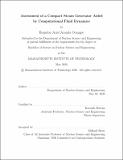Assessment of a compact steam generator aided by computational fluid dynamics
Author(s)
Aranda Ocampo, Brandon Ariel.
Download1191905265-MIT.pdf (1.598Mb)
Other Contributors
Massachusetts Institute of Technology. Department of Nuclear Science and Engineering.
Advisor
Koroush Shirvan.
Terms of use
Metadata
Show full item recordAbstract
Steam generators are an essential component in nuclear power plants which serve to transfer thermal power from a liquid coolant to steam by boiling water. Even with many advancements in the designs of steam generators, they still require extremely large sizes and have high costs which are major hurdles for the implementation of new reactor designs such as Small Modular Reactors. Using a Printed Circuit Heat Exchanger (PCHE) such as those from the company HeatricTM as a steam generator to boil the liquid in the secondary side has potential to overcome the disadvantages of conventional steam generators. Computational Fluid Dynamics was used to aid the assessment of such compact steam generator. The models used were bench marked against a 1-D MATLAB code which simulated a compact steam generator with straight, semi-circular channels. The same conditions were used to simulate a zig-zag, semi-circular PCHE. The zig-zag configuration resulted in a 22 °C increase in superheat over the straight channel configuration at the cost of pressure drops that are over 4 times higher but yet easily accommodated. The PCHE was also simulated in different orientations with respect to gravity and determined there is little advantage in using a vertical layout regarding pressure drop for the zig-zag configuration. Plugging of a single channel was also simulated to determine the effect on surrounding channels and potential hot spots.
Description
Thesis: S.B., Massachusetts Institute of Technology, Department of Nuclear Science and Engineering, May, 2020 Cataloged from the official PDF of thesis. Includes bibliographical references (pages 63-65).
Date issued
2020Department
Massachusetts Institute of Technology. Department of Nuclear Science and EngineeringPublisher
Massachusetts Institute of Technology
Keywords
Nuclear Science and Engineering.